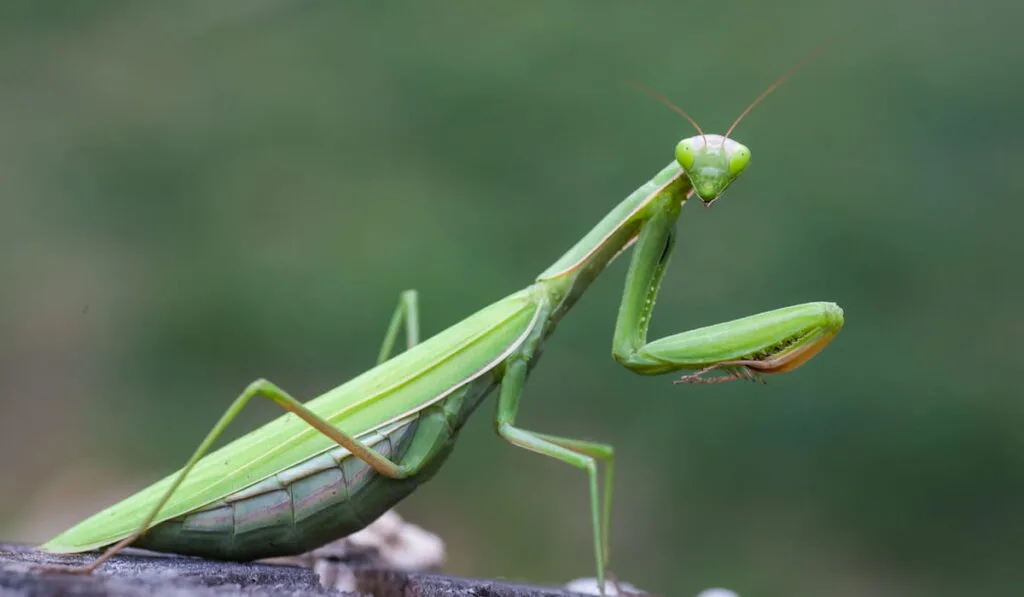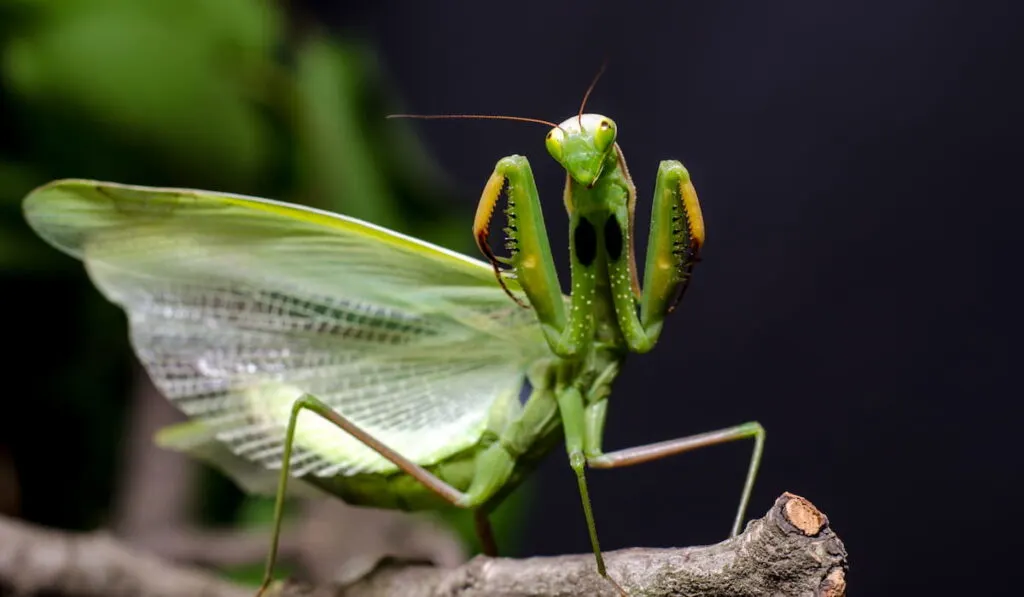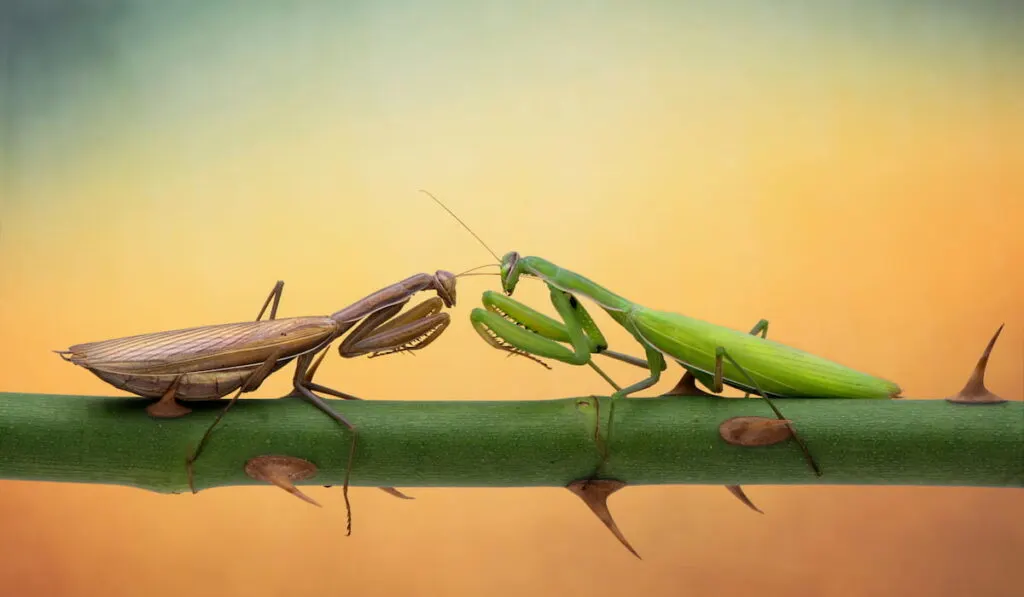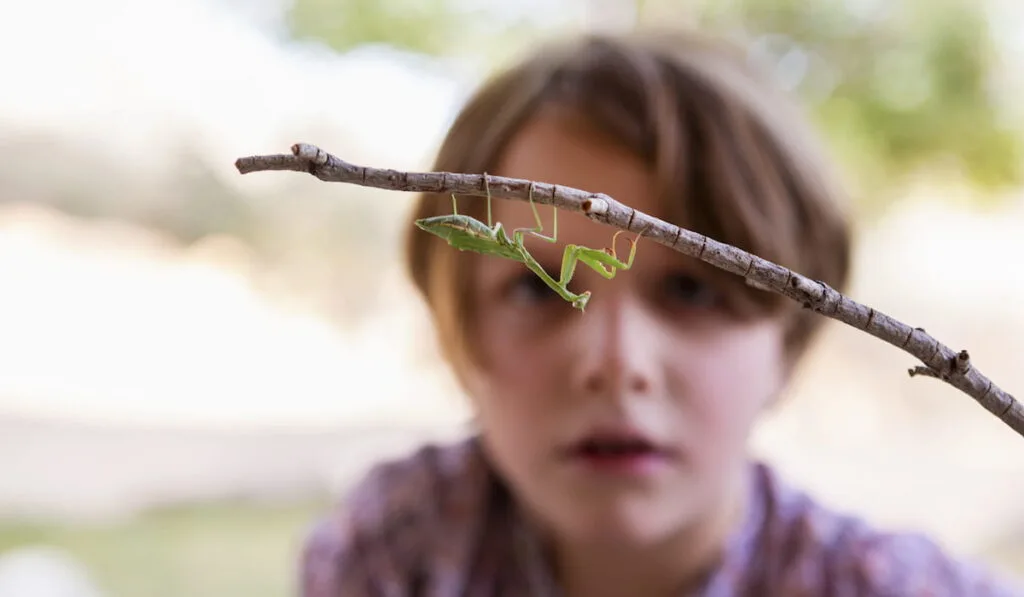With an undeniably alien body, a great head, unsettlingly large eyes and all other manners of angular, kind of creepy looking features, it is only natural to wonder about the full range of defense (and attack) capabilities of this bug. Seeing one in the wild, especially if you are not used to them, can be a bit of a shock. Like with most insects, too, one of the first things wondered is: do they bite?
While physically, yes, praying mantis are capable of biting, they rarely, if ever do. Their mouths do work, but they are more reserved for catching and eating prey than simple biting.

However, if severely threatened and physical displays and pinching do not work, they may snip. So, yes, they can bite, but they simply won’t and don’t bite humans in most circumstances.
These are fascinating, complex creatures. From their physical build to their history, there’s more to the story than them simply not being human flesh nippers by nature.
Table of Contents
Do they bite?
Can they bite? Yes. Do they bite? The chance of a praying mantis biting you is so slim, it is pretty much just about zero.
I have personally handled hundreds of praying mantis and have only ever been bit once. The wild, adult praying mantis did not appreciate being picked up and did bite drawing a single drop of blood.
The bite itself was less painful than an ants bite and no bandaid was required. Having handled quite a few of these green bugs, I do know that this particular incident was the exception and not the rule.
What do they bite or eat?
From a pure sustenance standpoint, praying mantises have a working mouth to eat their favorite prey: live insects. They don’t go after any bugs that are already dead, however.
Since people’s fingers are not on the menu of a praying mantis’s diet, they do not feel the need to chomp down. This is also thanks, in part, to those massive eyes they have: praying mantises have incredibly well-developed eyesight, meaning that not only do they not want to bite you, they are able to see, very clearly, that you are not a tasty insect and so are unlikely to deliver a bite by mistake.
What’s more, size is a big factor, too. While a larger mantis won’t bite you pretty much on principle, a praying mantis that is less than 2 inches long, physically can’t bite you. They are simply too small and their mouths can’t open wide enough to chomp down.
However, since there is always an exception to prove a rule, once in a while a praying mantis will bite. Just like with any other wild animal, read and respect their body language: a praying mantis that is assuming a defensive posture (standing as tall as possible, spreading out its legs and wings wide, opening its mouth) is feeling threatened, so back down and back away.
Even if they are not going to bite, having one of them launch itself at you is pretty nerve-wracking and unwelcome enough! If you continue to attack or harass the poor insect, they may resort to pinching you with their legs or even biting you.
Mantises rarely bite to begin with, so if you do find yourself bitten, it is most likely due to you mishandling them or threatening them, since humans simply as they pose no threat to praying mantises, nor do they look like meals.
However, even the largest of praying mantises still possess a relatively small mouth, so the odds of them even breaking the skin are slim. Mostly, a bite will feel more like a pincer grabbing you, with the skin being pinched but not penetrated.
I know this contradicts my experience above, but let me reiterate that my experience was with a large adult.
They also have been known to up their eating game and devour the occasional spider, lizard or frog. Or, alternatively, the female may decapitate or similarly maim and devour her male partner after mating.
It is actually one of the most popular facts people know about the praying mantis – that there is female-led cannibalism. After the male is through performing their mating dance, the female praying mantis has been known to bite off the male’s head or legs during or right after mating.
It should be noted, though, that this characteristic is not unique to praying mantises! While their rates of post-mating cannibalism are objectively high, they are often blown up to be more common than they are.
Though we may think of every mating session ending in cannibalism, that feast really only occurs less than 30% of the time.
What are their hunting tendencies?
They look like exacting alien hunters – and to many insects, that’s just what they are. With their long necks, ability to turn their heads 180 degrees and what amounts to literally hundreds of eyes, they can spot insect meals easily.
Praying mantis are also patient hunters, capable of staying very still and lying in wait to stalk their prey. Those impressive forelegs, long and bent and pincered with spikes made for ensnaring, are able to lash out and grab a bug or other small prey with lightning-fast reflexes – so fast, in fact, are these movements that they are almost impossible to see with the naked eye.
Praying mantises are excellent at staking out general areas that are ripe with prey. If you see one in your garden or yard, you can expect to often find them there, waiting on leaves, on flowers or in shrubbery for an unsuspecting meal to crawl by.
They also make use of lights at night (similar to a moth in attraction, but with a plan for feeding instead of a blind obsession) – they fly very well after dark and continue to hunt nighttime bugs for meals.
Their diets are very bug-centric, with their main prey being flies, crickets, grasshoppers and common garden bugs. Plus, praying mantises come equipped with sharp mandibles in their mouths, perfect for tearing apart even the thickest of buggy exoskeletons and even ripping into the through flesh of frogs, lizards – and sometimes even small birds.
What is unique about the praying mantis as a whole species?

Though the ubiquitous term “praying mantis” is pretty much used exclusively, there are a few subspecies that do differ amongst mantises. There are three main types: Chinese, European and Carolina.
The Chinese praying mantises are the largest, measuring at 3 to 5 inches long. They can be either brown or green, but all have a yellow or pale green stripe that runs down the edges of their wings.
Next up in size is the European, usually around 3 inches long. They are often the most commonly seen types, and are that distinctive bright green color, with a flashy little black and white bullseye mark on the insides of each of their forelegs.
Finally, the Carolina praying mantises are the smallest at just 2 to 2 ½ inches long. They can be green or a woodsy, mottled grayish brown color. The females of the Carolina variety are flightless, as their wings are much too short.
The Lifespan of a Praying Mantis
No matter the praying mantis, though, according to National Geographic, they share an average lifespan of one year. This makes them well-suited to a lifecycle in the wild, but hard to breed and raise. Such short lifespans make for a very small window of breeding, and one that keeps cycling up.
They also are the same when it comes to reproducing: female praying mantises lay hundreds of eggs at a time, enclosed up in a small case. From these eggs hatch tiny nymphs, which look for all intents and purposes just like very much shrunken and highly delicate versions of adult praying mantises. These babies will continue to grow over the course of the next year.

Though not really a familial selling point, praying mantises are actually related to cockroaches, though they are far less off-putting. The family traits can best be seen in their rigid and strong exoskeleton, along with the common, three-part insect build of a thorax, and abdomen and a head. They also all have two wings and two antennae.
What really sets them physically apart, aside from their complex eyes (two large, compound eyes that house quite legitimately hundreds of smaller eyes within them, plus another host of three, regular eyes), are their legs.
The front legs of the praying mantis are insect-catching and killing machines lined with barbed teeth that make escape all but impossible for prey that the mantis has captured.
These legs are scientifically known as raptorial legs, and the praying mantis can use them not only to trap prey but also as defense weapons against possible harm.
Praying mantises are also master adaptors and are skilled in the art of disguise. Their range of green to brown body colors ensures they will be able to blend in with many an environment, including grasses, leaves, sticks and more.
Praying mantis are found in a multitude of different environments and adapt themselves to the conditions of their homes, from lush jungle fauna to more barren landscapes.

What do you do if you are bitten?
If you are one of the unlucky very few and you have found yourself to be bitten by a praying mantis, there are a few things you can do. First, on the bright side, do know that praying mantises are non-venomous, so they will not have injected you with any kind of poison or similarly stinging substance.
In fact, their bites are so non-consequential, you really only need to wash your hands! However, you should follow stricter hand washing conventions, to ensure your skin is fully cleaned.
Even though they don’t secrete venom, you still don’t want wild bug saliva hanging about on you, especially when they have made a tiny puncture.
Wet your hands with soap and warm water, lathering up for at least 20 seconds. Be sure to include the back of your hands, between your fingers and also your wrists. Then rinse with warm water until all the soap is off of your hands. Lastly, be sure to sure your hands fully to ensure they are clean.
If the praying mantis bit down with excessive force, or it just happened to nick you at the right angle, you may need to take a pain reliever until the stinging wears away.

You are generally in no danger of any allergic reaction, swelling or inflammation, though. In fact, there may be more chance of you experiencing inflammation or skin breakage from contact with some of the barbs on their forelegs than from an actual bite.
However, if a praying mantis bites a pet, do keep an eye on them. Since they can’t tell you when something feels off, you may need to look for adverse signs on your own. Just like you would yourself, too, wash and sterilize the bite and make sure your pet keeps the area clean.
In order to prevent against praying mantis bites (or, really, any insect bites), you should always wear gloves when gardening. Similarly, if you plan on being in tall grasses or out in wooded areas, always wear long pants and socks to protect exposed skin.
Why are praying mantises well-liked?
Though it varies from state to state and region to region, praying mantises are often looked to as not only harmless insect, but welcome ones! Since they have an appetite for live bugs and a skill for seeing and hunting them, they are often used as a natural means by gardeners to control destructive pests.
With heads capable of turning that aforementioned Exorcist-like 180 degrees and eyes that can see quite clearly, they are a friend to gardeners by being hunting machines, eating up aphids, invasive beetles and other pest insects that would normally be feasting on plants and destroying gardens.
They even have a built-in population control mechanism, thanks to the females eating the males, so they rarely have a population count that is too high.
This is an awesome video that has a lot of great information.
Gardeners who wish to keep the helpful praying mantis around should be careful to not use (or at least limit) the spraying of pesticides and insecticides. These may kill pest bugs, but they will also harm praying mantises.
Don’t let their fearsome features and cannibalistic reputation scare you. Praying mantises are pretty well-renowned for being chill bug buddies. They may attack and eat insects, but they rarely if ever will bite a person. That is what makes them so welcome in many a garden: they eat up the pests but never bite the human hand that houses them.
